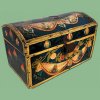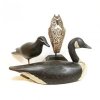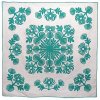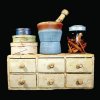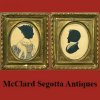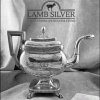Sotheby's American Art
November 21st, 2016
New York City
Photos courtesy Sotheby’s
There were about 75 people in the salesroom at Sotheby’s on November 21, 2016, for the American art sale. Buoyed by glasses of champagne and white wine, the crowd gathered a little before the 4 p.m. auction to chat about the state of the art market, the stock market, and their plans for Thanksgiving, a mere three days away.
It was refreshing and uplifting to see a crowd in an auction salesroom since so many sales are increasingly made online and on the phones. Although most of the more expensive lots sold on the phones—the phone bank had over 20 Sotheby’s specialists—there were some sales made in the room. A fraternity of New York dealers sitting together made several buys while other dealers sat separately or stood in the back of the room to bid.
The sale totaled $28.6 million, with 81 of the 113 lots offered sold, for a 71.7% sell-through rate.
The top lot of the sale was Norman Rockwell’s Which One? (Undecided; Man in Voting Booth). Chased by three phone bidders, the 1944 oil painting hammered down at $5.6 million (est. $4/6 million). A buyer bidding on the phone paid $6,537,500 for it, including buyer’s premium. Sotheby’s had guaranteed the painting, introducing it to auction for the first time. Furthermore, the auctioneer gave a presale announcement indicating that there was an irrevocable bid on the lot “that will be executed during the sale at a value that ensures that the lot will sell,” according to Sotheby’s auction catalog.
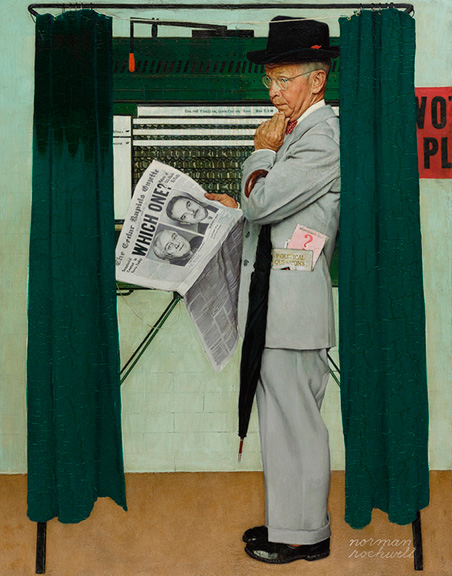
Norman Rockwell’s Which One? (Undecided; Man in Voting Booth), painted in 1944, was the top lot of the sale and was on the front cover of Sotheby’s catalog. Three phone bidders pursued it, and the successful one paid $6,537,500 for the signed 37" x 29" oil on canvas. The painting, heavily marketed and guaranteed by Sotheby’s, had an estimate of $4/6 million and came from the estate of Ogden Mills Phipps, who had acquired it circa 1985. The image of the voter from Cedar Rapids, Iowa, standing in a voting booth contemplating his choice was on the front cover of the Saturday Evening Post, one of almost 70 cover images Rockwell painted for the publication during the 1940s. Undecided illustration © 1944 SEPS. Used with permission from Curtis Licensing. All rights reserved.
“The election-themed painting now ranks among the top auction prices achieved for the artist,” said Liz Sterling, head of Sotheby’s American art department. She noted the “strong interest in works spanning the full diversity of genres represented in our sales, from Childe Hassam’s Impressionist New York Street Scene to Milton Avery’s modern Woman and Orange Mandolin and Albert Bierstadt’s Western picture of Yosemite…. We have seen interest in these works from collectors throughout November, as they hung beautifully alongside our Impressionist and modern and contemporary art exhibitions, in addition to our immediate presale show.”
One painting that hung on the wall of the tenth-floor exhibition space was Rockwell Kent’s Gray Day, a signed and dated 1935-37 oil on canvas, estimated at $400,000/600,000. When it sold for $852,500, it established an auction record for the artist. A buyer who left a bid with the auctioneer and a phone bidder wanted it—the phone buyer got it for $700,000 plus the buyer’s premium.
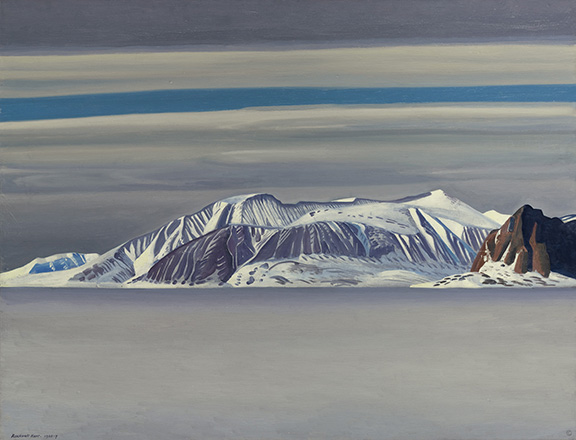
Gray Day by Rockwell Kent (1882-1971) sold to a buyer bidding on the phone for $852,500 (est. $400,000/600,000), establishing an auction record for the artist. Painted during Kent’s last trip to Greenland, the signed 34" x 44½" oil on canvas, dated “1935-7,” mounted on panel by the artist was exhibited prominently on Sotheby’s tenth floor for two weeks. The painting was guaranteed by the auction house and had once been part of the collection of Joseph J. Ryan, a patron of Kent. Scott Ferris, who is preparing the catalogue raisonné on the artist, wrote an essay on the painting for Sotheby’s catalog, while Richard V. West, who is preparing The Paintings of Rockwell Kent: An Annotated Checklist, wrote, “In Gray Day, Kent was inspired by the beauty and majesty of the vast icy landscapes of Greenland to create a Modernist masterpiece that combines the simplicity and discipline of an abstract composition with the delight in nature that permeates all his paintings.”
For Kent aficionado Scott R. Ferris, the auctions at Sotheby’s and Christie’s were “a great opportunity to see a broad range of Kent’s paintings, from Gray Day to the study Alaska Impression.” Sotheby’s “went all out with Gray Day,” he said in a telephone interview after the auction. “Getting the extra pages in the catalog and putting it on the back cover and hanging it on the tenth floor with the Modernists really let people see the painting. Sotheby’s knew there was something special and different about this painting,” he commented.
“Next time with a strong [Kent] painting, it should bring over $1 million,” Ferris predicted.
Kent’s Alaska Impression, oil on panel, painted 1918-19, sold at Christie’s a day later on November 22 for $199,500 to a bidder on the phone. It had an estimate of $50,000/70,000. Iceberg; Sledge Dogs, Greenland, estimated at $300,000/500,000, sold for $703,500 to a man in the salesroom. The third Kent offering at Christie’s, Frozen Falls (Alaska) Ice Curtains failed to sell at auction, passing at $170,000. It had an estimate of $200,000/300,000. All three came from the Oak Ridge, Virginia, collection of J.J. Ryan. Gray Day once belonged to Ryan as well.
For dealer Andrew Schoelkopf, a partner in Menconi + Schoelkopf, New York City, “There are early signs the American art market is changing. We’re encouraged,” he said in a telephone interview while in Miami for Art Basel. “Although the offerings in the auctions weren’t fresh or super interesting, the results weren’t a surprise—they were strong, as expected.”
 He noted, however, “Great things are selling very well, which is reassuring, while ordinary things aren’t getting great prices. There’s a sensible approach to the market, and connoisseurship matters, as does rarity, context, and condition.” Furthermore, “We’ve seen a constant progression in interest in the Modernists of the first half of the twentieth century—Stuart Davis, Marsden Hartley, Georgia O’Keeffe, Arthur Dove, and Oscar Bluemner,” he said, “and now there’s an excitement. New interest beats on. New young buyers are stepping in for the early material,” Schoelkopf noted.
He noted, however, “Great things are selling very well, which is reassuring, while ordinary things aren’t getting great prices. There’s a sensible approach to the market, and connoisseurship matters, as does rarity, context, and condition.” Furthermore, “We’ve seen a constant progression in interest in the Modernists of the first half of the twentieth century—Stuart Davis, Marsden Hartley, Georgia O’Keeffe, Arthur Dove, and Oscar Bluemner,” he said, “and now there’s an excitement. New interest beats on. New young buyers are stepping in for the early material,” Schoelkopf noted.
“Although too early to tell, there’s a good chance the spring sale season will be successful,” the private dealer said.
Further information is available online (www.sothebys.com) or by calling Sotheby’s at (212) 606-7000.

Joy of the Waters by Harriet Whitney Frishmuth (1880-1980), bronze, 61" high, estimated at $250,000/350,000, sold for $300,000 to New York City dealer Fred Hill of Collisart, LLC, who was bidding in the salesroom. Cast in 1920 by Roman Bronze Works, Inc., New York, this example is from an edition of 44.
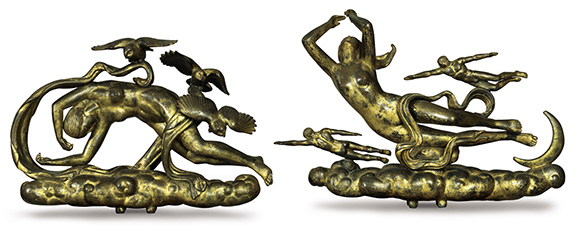
This pair of Paul Howard Manship (1885-1966) parcel-gilt bronze sculptures, Evening and Night, 1938, sold to a buyer bidding on the phone with head of department Liz Sterling. Estimated at $100,000/150,000, the figures are reductions of two of the four figures representing the “Moods of Time” that Manship created for the 1939 New York’s World Fair. The buyer paid $348,500 for them. Evening measures 13¾" x 21" x 6"; Night, 16" x 24" x 9".
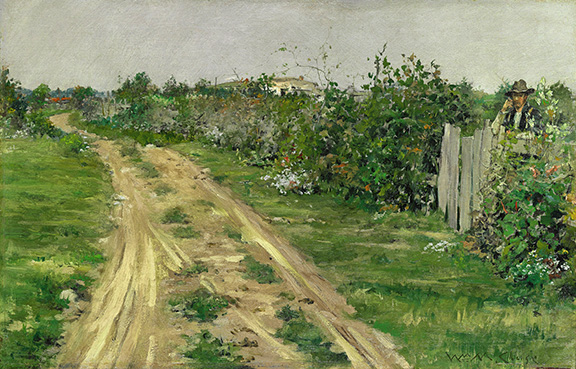
William Merritt Chase (1849-1916) painted The Old Road, Flatbush in 1887, the same year he and his new wife, Alice, moved to Brooklyn from the artist’s Tenth Street studio in New York City. The plein-air painting, oil on panel, 10¼" x 15?", signed and inscribed, sold to New York City dealer Debra Force, who was bidding in the salesroom, for $372,500 (est. $400,000/600,000). The first owner of the painting was American art collector Charles Lang Freer, founder of what is now the Freer Gallery of Art at the Smithsonian Institution; he purchased it directly from the artist, according to an entry in Sotheby’s catalog.
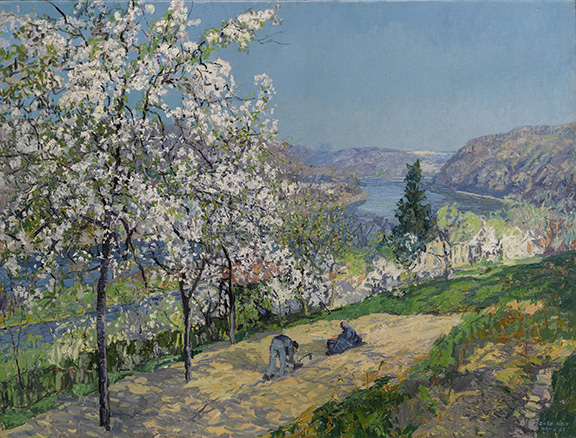
Two phone bidders went after Point Pleasant by Edward Willis Redfield (1869-1965), which was estimated at $250,000/350,000. It sold for $492,500. The 38¼" x 50¼" oil on canvas, signed, dated “May 5, 26,” and in its original frame designed by Frederick Harer, depicts two farmers working the land on the banks of the Delaware River. Point Pleasant is an area north of Center Bridge in Bucks County, where Redfield lived.

This recently discovered work by N. C. Wyeth, untitled (The Farmer), painted circa 1911, sold to a woman on her cell phone in the salesroom who bought it for a private collection. The 36" x 23¾" oil on canvas, estimated at $250,000/350,000, sold for $456,500. The underbidder was on the phone with a Sotheby’s specialist and stopped bidding at $360,000. Painted for Popular Magazine, which commissioned Wyeth to create scenes of rural life and adventure, it had been in a private collection in White Plains, New York, since 1942 and had descended in the family.
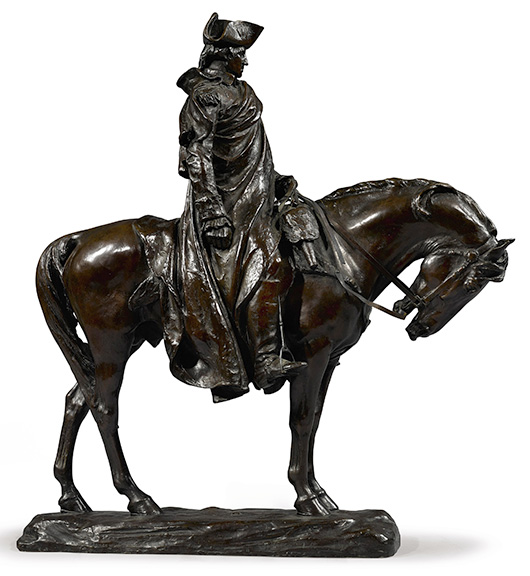
George Washington at Valley Forge, bronze, 25½" high, by Henry Merwin Shrady (1871-1922) was cast from the maquette Shrady created in preparation for his 1906 monument. It sold to a buyer bidding on the phone for $200,000 (est. $40,000/60,000). Two other phone bidders chased it. It is inscribed “H.M. Shrady” and “Roman Bronze Works N-Y.” Shrady submitted the maquette as part of a competition to design a statue of George Washington for the Brooklyn Plaza of the Williamsburg Bridge (now Continental Army Plaza). According to Sotheby’s, additional casts are in the collections of the Gilcrease Museum, Tulsa, Oklahoma; the Henry Morrison Flagler Museum, Palm Beach, Florida; and the Metropolitan Museum of Art, New York City.
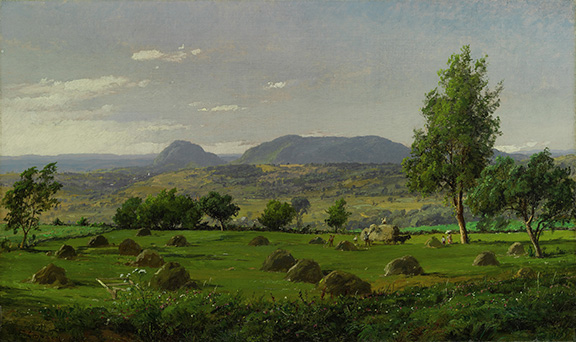
Jasper Francis Cropsey (1823-1900) painted Mounts Adam and Eve—Haymaking in 1883. The 12" x 20" signed oil on canvas, estimated at $60,000/80,000, sold to a bidder on the phone, who paid $212,500 for it. The painting will be included in the forthcoming volume II of the catalogue raisonné of the artist’s work to be published by the Newington-Cropsey Foundation.
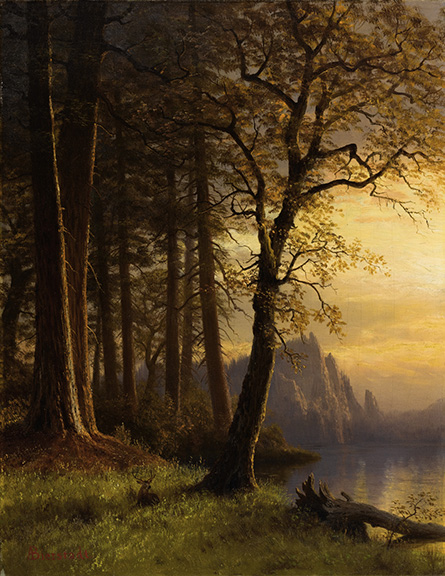
Sunset in California, Yosemite by Albert Bierstadt (1830-1902) sold to dealer Mark L. Brock, who was standing at the back of the salesroom. The Concord, Massachusetts, dealer, paid $1,068,500 for the signed 28½" x 22" oil on canvas, which had an estimate of $1/1.5 million. It had sold at Sotheby’s on December 4, 2002, for $807,000. The painting was one of several sold to benefit of the Ed Snider Youth Hockey Foundation, which focuses on the urban youth of Philadelphia. Edward M. Snider (1933-2016) was a former owner of the Philadelphia Flyers.
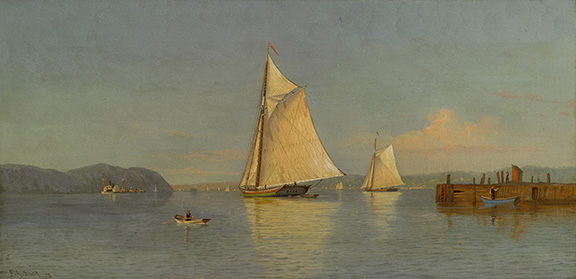
Haverstraw Bay, New York by Francis Augustus Silva (1835-1886) sold to New York City dealer Michael Altman, sitting in the salesroom with colleagues and clients, for more than three times the high estimate. Altman paid $262,500 (est. $50,000/70,000) for the 9" x 18" signed and dated fresh-to-market painting.
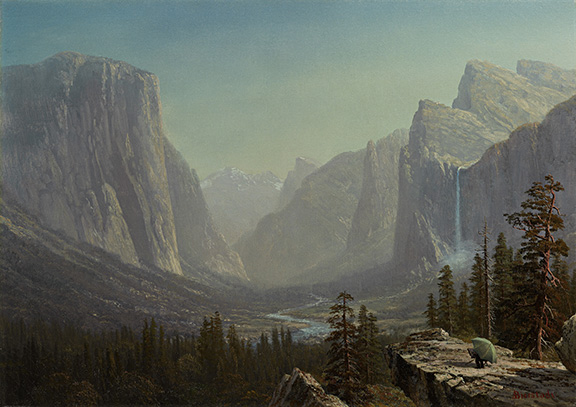
Yosemite by Albert Bierstadt (1830-1902), painted circa 1875 and possibly once owned by Ulysses S. Grant, sold for $1,392,500 to a buyer bidding on the phone with Sotheby’s head of department Liz Sterling. Dealer Michael Altman was the underbidder. The 20" x 28" oil on canvas contains a rare self-portrait of Bierstadt painting under an umbrella. President Grant and Bierstadt knew one another as early as 1877 and are known to have dined together at Delmonico’s restaurant in 1881, according to Sotheby’s catalog.
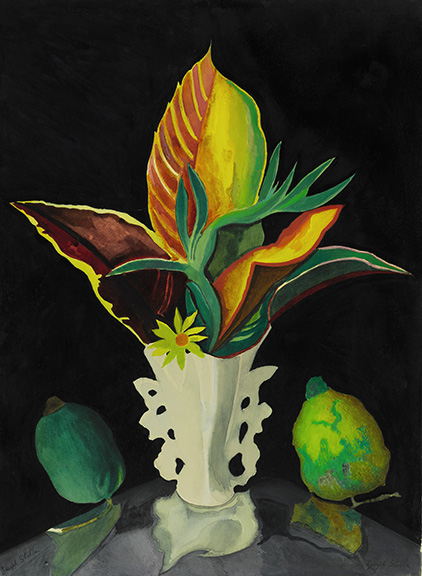
Joseph Stella (1877-1946), Croton Leaves in a Vase, watercolor and ink on paper, 28" x 20½", signed twice, sold for $68,750 (est. $30,000/50,000) to an art advisor from Citibank who was in the salesroom. Dealer Louis Salerno of Questroyal Fine Art, New York City, was the underbidder. It came from the Jeffrey M. Kaplan collection.
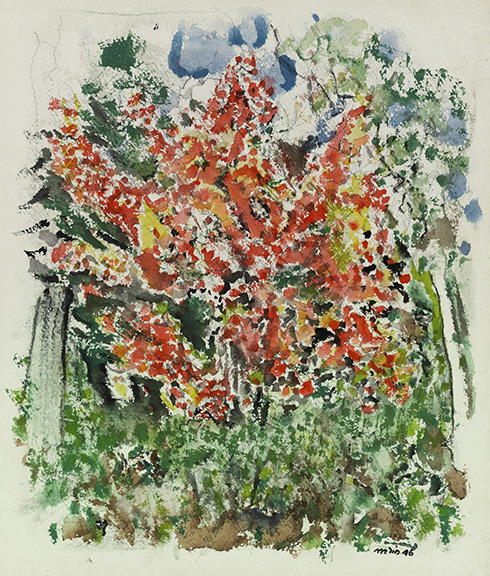
Maple in Autumn by John Marin (1870-1953), from the Jeffrey M. Kaplan collection, sold to a bidder in the salesroom for $62,500. The watercolor and charcoal on paper, signed and dated ’46, 19" x 16 1/8", was estimated at $20,000/30,000. An art advisor from Citibank bought it for a client, she said.
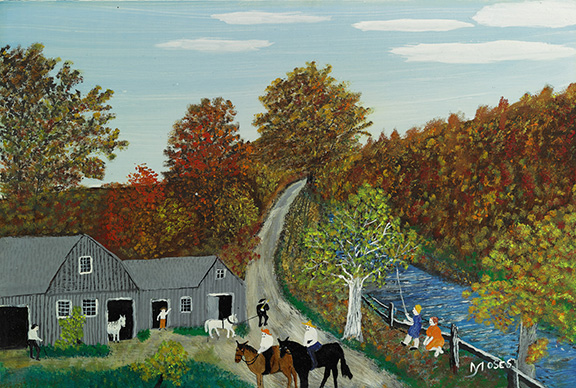
October by Anna Mary Robertson “Grandma” Moses (1860-1961), 12" x 18", sold to a bidder on the phone for $62,500 (est. $25,000/35,000). The oil on masonite is signed, titled, dated June 4, 1954, and numbered 1622 on an original Grandma Moses label affixed to the reverse.
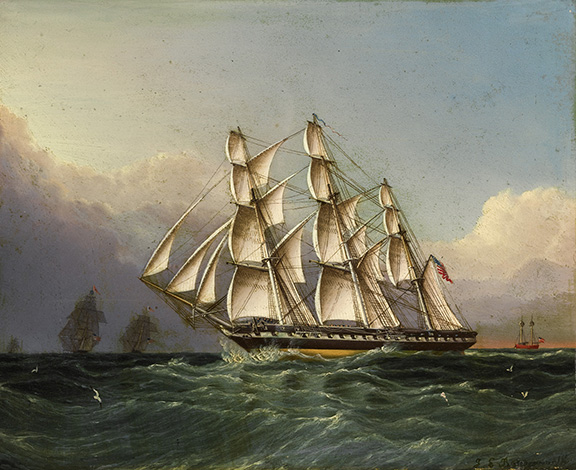
This 8" x 10" oil on board of the U.S.S. “Constitution” (“Old Ironsides”) Off Sandy Hook (3 Master Forty Guns) by James Edward Buttersworth (1817-1894), painted circa 1870, sold to a bidder on the phone for $62,500 (est. $25,000/35,000).
Originally published in the February 2017 issue of Maine Antique Digest. © 2017 Maine Antique Digest
